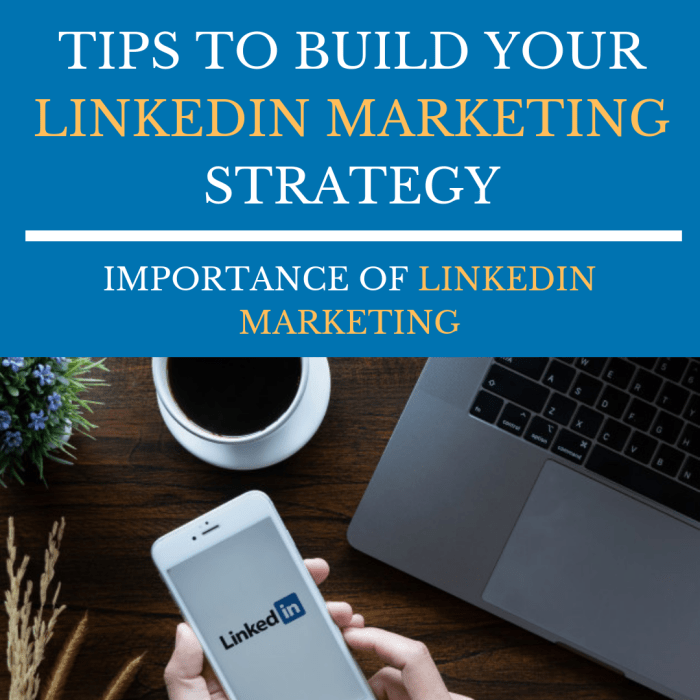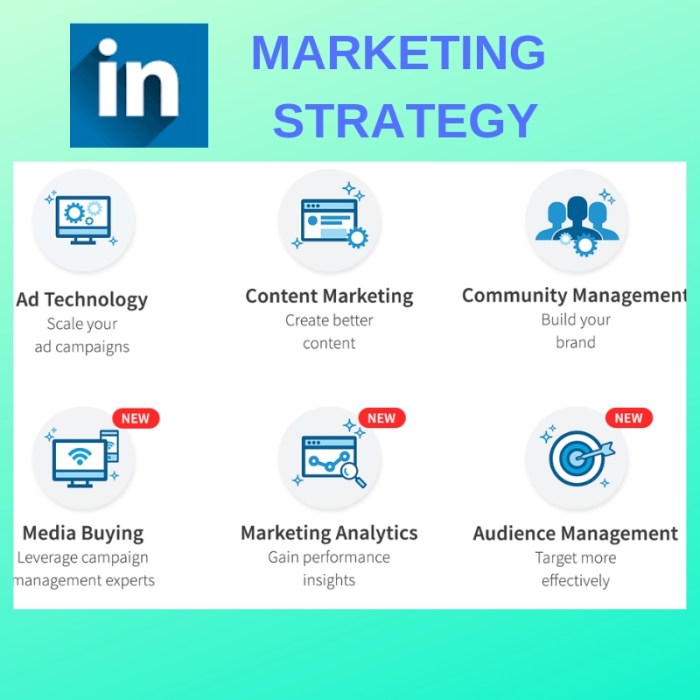Building a LinkedIn Marketing Strategy dives deep into the world of LinkedIn marketing, offering insights and tips for creating a successful strategy that resonates with your audience. Get ready to elevate your LinkedIn game!
Introduction to LinkedIn Marketing Strategy

A LinkedIn Marketing Strategy refers to a plan of action designed to promote a brand, product, or service on the LinkedIn platform. It involves creating and sharing valuable content, engaging with the target audience, and leveraging various LinkedIn features to achieve marketing goals.
Having a well-defined LinkedIn Marketing Strategy is crucial for businesses looking to establish a strong online presence, build credibility, and generate leads. By strategically utilizing LinkedIn’s professional network, companies can reach a highly targeted audience of professionals and decision-makers.
Examples of Successful LinkedIn Marketing Strategies
- LinkedIn’s own “In It Together” campaign, which focused on providing support and resources for professionals during the COVID-19 pandemic.
- Adobe’s “Make It An Experience” campaign, which showcased customer success stories and highlighted the benefits of using Adobe products for creating memorable experiences.
- Microsoft’s “Empower Your Future” campaign, which aimed to empower individuals with the necessary skills and tools to succeed in a digital world.
Setting Objectives for LinkedIn Marketing

Setting objectives for a LinkedIn marketing strategy is crucial for success. By setting SMART objectives, companies can ensure their goals are specific, measurable, achievable, relevant, and time-bound. This helps in creating a clear roadmap for the marketing efforts on LinkedIn.
Examples of Specific Objectives
- Increase brand awareness by reaching 10,000 new followers on LinkedIn within 6 months.
- Generate 100 leads from LinkedIn ads in the next quarter.
- Drive traffic to the company website by 20% through LinkedIn posts in the next year.
Significance of Aligning Marketing Objectives with Business Goals
Setting marketing objectives that align with overall business goals is essential for ensuring that all efforts contribute to the success of the company. By aligning marketing objectives with business goals, companies can ensure that their LinkedIn marketing strategy is focused on driving results that directly impact the bottom line. This alignment helps in creating a cohesive and effective marketing approach that maximizes the impact of LinkedIn efforts on the overall business success.
Target Audience and Persona Development
Identifying the target audience on LinkedIn is a crucial step in creating a successful marketing strategy. By understanding who your audience is, you can tailor your content and messaging to better reach and engage with them.
Creating buyer personas for LinkedIn Marketing involves developing detailed profiles that represent your ideal customers. These personas include demographic information, interests, pain points, and buying behaviors. By creating these personas, you can better understand your audience and create content that resonates with them.
Tailoring Content to Different Segments
To tailor content to different segments of your target audience on LinkedIn, consider the following tips:
- Segment your audience based on factors like job title, industry, and location. This will allow you to create content that speaks directly to each group.
- Personalize your messaging by addressing the specific needs and pain points of each segment. This will help you establish a connection with your audience.
- Use different formats such as articles, videos, and infographics to cater to the preferences of each segment. This will make your content more engaging and appealing.
- Monitor the performance of your content and adjust your strategy based on the feedback you receive from each segment. This will help you optimize your approach over time.
Content Strategy for LinkedIn
In today’s digital age, content is king, especially on a professional platform like LinkedIn. Your content strategy plays a crucial role in attracting and engaging your target audience, ultimately helping you achieve your marketing objectives.
Types of Content that Perform Well on LinkedIn
- Articles and Blog Posts: Providing valuable insights and industry knowledge can position you as a thought leader in your field.
- Visual Content: Images, infographics, and videos tend to grab users’ attention and increase engagement.
- Polls and Surveys: Encouraging interaction and feedback from your audience can help build a sense of community.
- Case Studies and Success Stories: Showcasing real-world examples of your work can establish credibility and trust with potential clients or partners.
Creating Engaging and Shareable Content for LinkedIn
- Know Your Audience: Tailor your content to resonate with your target audience’s interests, pain points, and preferences.
- Use Compelling Headlines: Capture attention with concise and intriguing headlines that entice users to click and read more.
- Include Visuals: Incorporate eye-catching images, videos, or infographics to make your content more appealing and shareable.
- Encourage Engagement: Pose questions, invite comments, and prompt discussions to foster interaction and connection with your audience.
The Role of Storytelling in Building a Strong Presence on LinkedIn
Storytelling is a powerful tool for humanizing your brand and creating emotional connections with your audience. By sharing authentic stories, you can engage users on a deeper level, establish trust, and differentiate yourself from competitors. Whether it’s narrating your company’s journey, highlighting customer testimonials, or showcasing employee experiences, storytelling can help you stand out and leave a lasting impression on LinkedIn.
Building a LinkedIn Company Page
Creating a LinkedIn Company Page is essential for businesses looking to establish a professional online presence. A well-optimized Company Page can help attract potential customers, engage with followers, and showcase your brand effectively.
Key Elements of an Optimized LinkedIn Company Page
- Company Logo and Cover Image: Use high-quality images that represent your brand effectively.
- About Section: Provide a concise and compelling description of your company, including key information and s for search optimization.
- Company Updates: Regularly post updates, news, and relevant content to keep followers engaged.
- Employee Showcase: Highlight key employees to add a personal touch to your page.
- LinkedIn Analytics: Use analytics to track the performance of your Company Page and adjust your strategy accordingly.
Tips to Enhance the Visual Appeal of a Company Page
- Use a consistent visual theme that aligns with your brand identity.
- Incorporate multimedia elements such as videos, images, and infographics to make your page more engaging.
- Utilize LinkedIn’s customizable features to create a unique and visually appealing layout.
- Optimize your content for mobile viewing to ensure a seamless experience for users on different devices.
Importance of Regular Updates and Engagement on a Company Page, Building a LinkedIn Marketing Strategy
Regularly updating your Company Page with fresh content and engaging with your audience is crucial for maintaining a strong online presence. By keeping your followers informed and involved, you can build credibility, foster relationships, and attract new opportunities for your business.
Leveraging LinkedIn Groups and Communities
Engaging with LinkedIn Groups and Communities can be a powerful strategy to expand your reach and connect with your target audience in a more focused and meaningful way.
Benefits of Participating in LinkedIn Groups
- Increased visibility and credibility within your industry or niche.
- Opportunities to establish thought leadership by sharing valuable insights and expertise.
- Potential for networking and building relationships with like-minded professionals.
- Access to valuable industry discussions, trends, and insights.
Strategies for Effective Engagement
- Join groups that are relevant to your industry or target audience.
- Contribute valuable content by sharing articles, insights, and participating in discussions.
- Avoid overly promotional posts and focus on providing value to group members.
- Engage with other members by commenting on their posts and offering helpful advice.
Importance of Providing Value and Building Relationships
Building relationships within LinkedIn Communities is crucial for long-term success in marketing. By consistently providing value, sharing insights, and engaging with others, you can establish trust and credibility among your peers and potential clients. This can lead to valuable connections, collaborations, and business opportunities that may not have been possible otherwise.
Using LinkedIn Analytics for Optimization: Building A LinkedIn Marketing Strategy
Utilizing LinkedIn Analytics is crucial for measuring the performance of your Marketing Strategy on the platform. By analyzing the data provided, you can gain valuable insights into the effectiveness of your campaigns and make informed decisions to optimize your approach.
Key Metrics to Track on LinkedIn
- Engagement Rate: Measure the level of interaction your content receives, such as likes, comments, and shares.
- Click-Through Rate (CTR): Track how many users clicked on your content or ads to visit your website.
- Follower Growth: Monitor the increase in your follower count over time to assess your page’s popularity.
- Conversion Rate: Evaluate the percentage of users who completed a desired action, like signing up for a webinar or downloading a resource.
Examples of Data-Informed Strategy Adjustments
After analyzing LinkedIn Analytics, you may discover that a particular type of content, such as videos, generates higher engagement rates compared to text posts. In response, you can adapt your content strategy to focus more on video content to maximize results.
Furthermore, if you notice that a specific demographic segment engages more with your ads during certain times of the day, you can schedule your campaigns to target them at optimal times for increased effectiveness.
